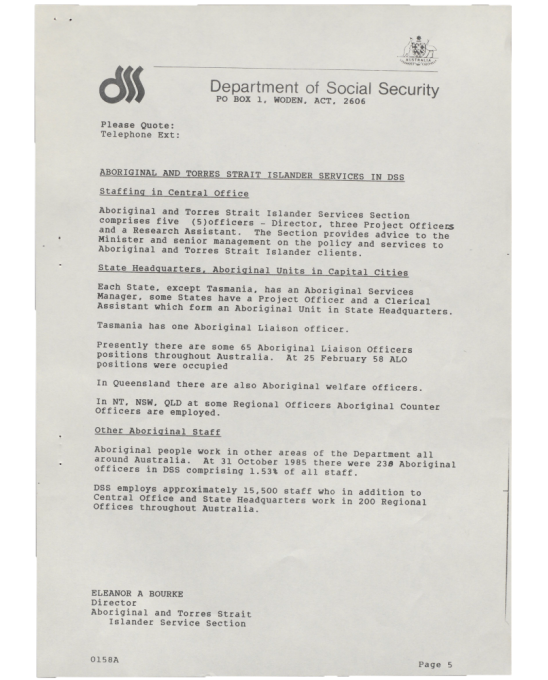
Senior Aboriginal public servant reflects on history of discrimination
DSS Director Eleanor Bourke presented a concise timeline of Aboriginal and Torres Strait Islander people's access to government payments at a youth conference.
... the Social Security Act discriminated against Aboriginals. They did not have the same entitlements to pensions, benefits and allowances ...
| Attachment | Size |
|---|---|
| bourke-speaking-notes.pdf | 2.11 MB |
| Attachment | Size |
|---|---|
| bourke-speaking-notes-plaintext_0.docx | 47.35 KB |
At the 1986 National Aboriginal and Torres Strait Islander Youth Conference, Eleanor Bourke presented a history of Aboriginal peoples’ access to government payments and highlighted servicing arrangements. Bourke, a Wergaia and Wamba Wamba woman, was Director of Aboriginal and Torres Strait Islander Services at the Department of Social Security (DSS).
Bourke’s timeline from 1908 to 1977 showed how the government excluded Aboriginal people from social services for many years. It covered key dates, from complete exclusion to changes to the Social Services Act in 1966. She concluded that ‘Aboriginals are now entitled to the full range of benefits’.
Bourke explained that the 1966 changes that removed parts of the Act that excluded Aboriginal people posed a ‘dilemma’ to DSS. There was disagreement among government about whether to give Aboriginal people their payments in full or whether to manage part of the payment for them. Some officials were worried Aboriginal people wouldn’t be able to manage their own money. Bourke described DSS’s decision to give people only part of their payments as having ‘overtones of paternalism and discrimination’.
Throughout this presentation, Bourke talked about past issues in the social security system. This overview seemed to have been drawn from the Report of the Interdepartmental Working Party on Aboriginal Employment (1976:26–29).
Bourke played an important role in leading change in DSS. As Director of the Aboriginal and Torres Strait Islander Service Section, Bourke worked to make sure Aboriginal and Torres Strait Islander people got the government payments they were eligible for. In a chapter she later wrote for a book about Aboriginal and Torres Strait Islander women’s experiences of higher education, she recalled:
‘I was responsible for developing the National Aboriginal and Torres Strait Islander Liaison Officer Scheme, and I was also responsible for the publicising of entitlements with respect to Social Security eligibility which Aboriginal people seemed to be missing out on at the time.’ (Bourke in Bin-Sallik 2000:161)
One newer way of publicising eligibility and the important work of Aboriginal Liaison Officers (ALO) was through video. Bourke introduced a 1982 video about ALO Andrew Thomas.
Bourke was among many Aboriginal and Torres Strait Islander people working within the public service to improve outcomes for their communities.
Aboriginal staff continued to reflect on the history of access to services. In the 1990s, the Director of the Aboriginal and Torres Strait Islander Services Section of DSS, Lorraine Randall, would publish an updated timeline in an issue of an Aboriginal staff newsletter.
AIATSIS holds this conference paper in their collection. Included with the paper was a leaflet showing DSS’s Aboriginal and Torres Strait Islander services and roles in the department.
Read more about Bourke’s life and early career in her chapter ‘The circle is complete’ in the book Aboriginal women by degrees (2000). Commissioner Bourke is currently Chair of the Yoorrook Justice Commission.
Permissions
Permissions to reproduce this paper and quotes from ‘The circle is complete’ were granted by Commissioner Eleanor Bourke and Professor MaryAnn Bin-Sallik.
Citation
Bourke E (31 March 1986) ‘Background of social security payments to Aboriginals’ [conference presentation], National Aboriginal and Torres Strait Islander Youth Conference, Canberra.
